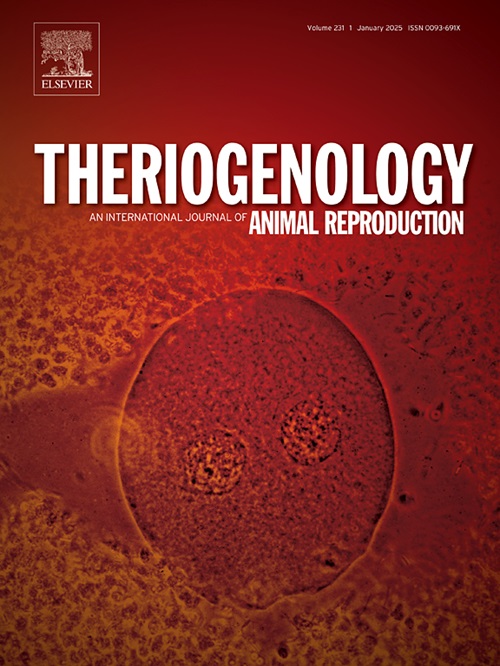暴露于“公对公效应”的公山羊刺激了繁殖活动,并确保在非繁殖季节公山羊和公山羊的高生育率
IF 2.4
2区 农林科学
Q3 REPRODUCTIVE BIOLOGY
引用次数: 0
摘要
在“公对公效应”的刺激下,公山羊在一个月的时间里,与光周期刺激下的公山羊一样,能有效地诱导母羊的周期。在此,我们研究了在非繁殖季节,性活跃(SA)的公山羊是否能刺激雌山羊和公山羊的繁殖,以及暴露在“公对公效应”下的公山羊是否能以与受光周期刺激的SA公山羊相同的效率和时间范围受精。3月,一组母山羊与公山羊隔离,另外三组与季节性不活跃的公山羊(SH)一起饲养。4月,隔离组加2只SA公山羊(SA组),其余3组按如下管理:1组加2只SA公山羊(SA + SH组);第二组2只SA公山羊,配以围裙防止交配(SA-围裙+ SH组);第三组加2只SH公山羊(SH + SH组)。在SA组(73%)、SA + SH组(70%)和SA-apron + SH组(76%)之间,结瘤率无显著差异;然而,这三个组的开玩笑率都高于SH + SH组(29%)。我们得出结论,在非繁殖季节,在同一群体中,SA公山羊对母山羊和公山羊的繁殖活动都有刺激作用。此外,在“公对公效应”的刺激下,公山羊的受精率和受精时间与SA公山羊相当。本文章由计算机程序翻译,如有差异,请以英文原文为准。
Male goats exposed to the “male-to-male effect” stimulate the reproductive activity and ensure high fertility of both does and male goats during the non-breeding season
Male goats stimulated by the “male-to-male effect” for one month and then introduced to anestrous does are as efficient as those stimulated by photoperiod in inducing cyclicity in anestrous does. Here, we determined whether the sexually active (SA) male goats can stimulate reproduction in does and males when housed together in the same flock during the non-breeding season, and whether male goats exposed to the “male-to-male effect” can fertilize does with the same efficiency and timeframe as SA males stimulated by photoperiod. In March, one group of does was kept isolated from male goats, while three other groups were housed with seasonally hypoactive males (SH). In April, the isolated group was joined with two SA male goats (SA group), while the other three groups were managed as follows: one group was joined with two SA male goats (SA + SH group); the second group was joined with two SA male goats which were fitted with aprons to prevent mating (SA-apron + SH group); and the third group was joined with two SH male goats (SH + SH group). The percentages of does that kidded did not differ among SA (73 %), SA + SH (70 %) and SA-apron + SH (76)% groups; however, all three had greater kidding rates than the SH + SH group (29 %). We conclude that SA male goats stimulate the reproductive activity in both does and male goats during non-breeding season when housed together in the same group. Furthermore, male goats stimulated by the “male-to-male effect” can achieve fertility rates and fertilization timeframe comparable to those of SA male goats.
求助全文
通过发布文献求助,成功后即可免费获取论文全文。
去求助
来源期刊

Theriogenology
农林科学-生殖生物学
CiteScore
5.50
自引率
14.30%
发文量
387
审稿时长
72 days
期刊介绍:
Theriogenology provides an international forum for researchers, clinicians, and industry professionals in animal reproductive biology. This acclaimed journal publishes articles on a wide range of topics in reproductive and developmental biology, of domestic mammal, avian, and aquatic species as well as wild species which are the object of veterinary care in research or conservation programs.
 求助内容:
求助内容: 应助结果提醒方式:
应助结果提醒方式:


